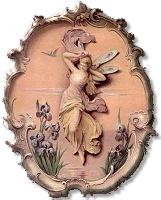Friday, February 6, 2009
Female Circumcision in the US
Like its male counterpart, circumcision of females has two histories. First it is a ritual or customary practice among tribal societies (mostly in Africa) and some Islamic communities. Secondly it is a medical intervention, justified by Victorian (and, in the USA, some twentieth century) doctors in exactly the same way as they rationalised circumcision of boys: to deter masturbation, to treat obscure nervous disorders such as hysteria, neurasthenia and epilepsy, and thereby to promote health.
Cult of Domesticity in Canada
http://www.musee-mccord.qc.ca/en/keys...
"The Cult of Domesticity"
Jennifer Salahub
The period 1840-67 can be characterized as an age of domesticity in the history of Canadian women. This was an era when appearances and material possessions played a major role in establishing a family's social and cultural aspirations. Daughters were educated to be modest and virtuous, and young wives to be industrious and self-sacrificing.
More About the Cherokee and the Trail of Tears
The Infamous Ernest Hogan
Ernest Hogan (born Ernest Reuben Crowders, 1865 - 1909) was the first African American entertainer to produce and star in a Broadway show (The Oyster Man in 1907) and helped create the musical genre of ragtime.
A native of Bowling Green, Kentucky, as a teenager Hogan worked in traveling minstrel shows as a dancer, musician, and comedian. In 1895 Hogan published several popular songs in a new musical genre, which he named ragtime. These hit songs included "La Pas Ma La" and "All Coons Look Alike to Me". The success of this last song created many derogatory imitations, known as "coon songs" because of their use of racist and stereotypical images of blacks.
While Hogan was considered one of the most talented performers and comedians of his day, his contribution to the racist "coon song" craze haunted him. Before his death, he stated that he "regretted" using the racial slur in his song.
Victorian Racism and the Chinese Massacre in Los Angeles

The Chinese population were consistently subject to ...
• low level jobs
• denied education or the ability to receive a higher education
• banned from testifying in court
• victims of race riots
(Please refer to Chinese Massacre of Los Angeles in 1871)

1882 The Chinese Exclusion Act: Congress prohibited all immigration of admission of unskilled Chinese laborers for 10 years with a ban against "lunatics, idiots, convicts, persons likely to become public charges." The Act was renewed in 1892 and the ban made "permanent" in 1902.
Victorian Era Racism in the US

In the USA, there was the famous (infamous?) Trail of Tears in 1838 occurring with the Native American population.
From Wikipedia:
The Trail of Tears was the forced relocation and movement of Native Americans from their homelands to Indian Territory (present day Oklahoma) in the Western United States. The phrase originated from a description of the removal of the Choctaw Nation in 1831. Many Native Americans suffered from exposure, disease, and starvation while en route to their destinations, and many died, including, for example, 4,000 of the 15,000 relocated Cherokee. Thousands of enslaved and free African-Americans (as slaves accompanying their Native American slaveowners and as former runaway slaves that were assisted by, assimilated by, or married to members of the tribes) accompanied the removed nations on the Trail of Tears.
In 1831, the Cherokee, Chickasaw, Choctaw, Muscogee (Creek), and Seminole (sometimes collectively referred to as the Five Civilized Tribes) were living as autonomous nations in what would be called the American Deep South. The process of cultural transformation (proposed by George Washington and Henry Knox) was gaining momentum, especially among the Cherokee and Choctaw. Andrew Jackson was the first U.S. President to implement removal of the Native Americans with the passage of the Indian Removal Act of 1830. In 1831 the Choctaw were the first to be removed, and they became the model for all other removals. After the Choctaw, the Seminole were removed in 1832, the Creek in 1834, then the Chickasaw in 1837, and finally the Cherokee in 1838.
Victorian Racism

The Comparative Worth of Different Races from the Heredity Genius (1869), pioneering eugenicist Francis Galton makes several references to the relative superiority of Europeans compared to what he called 'the lower races'. Although Galton was a gifted statistician, he was a significant contributor to the development of racist ideology.
Galton's work appears online HERE.
Gatlon states "the number among the Negroes of those whom we should call half-witted men, is very large" saying Negores are"so childish, stupid, and simpleton-like, as frequently to make me ashamed of my own species".

Prominent Victorians—like George Bernard Shaw, HG Wells, Harold Laski, Charles Dickens—supported the idea of racial purity.
Many hold that the Victorians were the proto-type for the Nazis and set the ground work in motion for them to build upon.

With respect to Victorian Era holocausts, Lord Lytton, the Viceroy of India in 1876. It would be the same year famine broke out in southern India that claimed 5.5 million lives. Lytton wrote,
"The grim doctrines of Thomas Malthus... still held great sway over the white rajas. Although it was bad manners to openly air such opinions in front of the natives in Calcutta, Malthusian principles, updated by Social Darwinism, were regularly invoked to legitimize Indian famine policy at home in England".
Lytton’s administration pushed the Anti-Charitable Contributions Act of 1877 in England prohibiting private relief and charitable donations for starving Indians illegal & threatened imprisonment. In 1878, he pushed the Vernacular Press Act that gave him the power to confiscate the press and paper of a local language newspaper publishing 'seditious material'. There was a public outcry in Calcutta led by the Indian Association.





